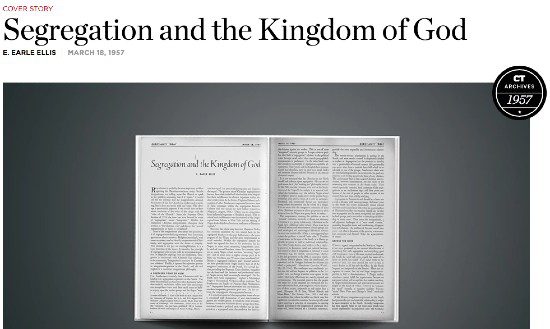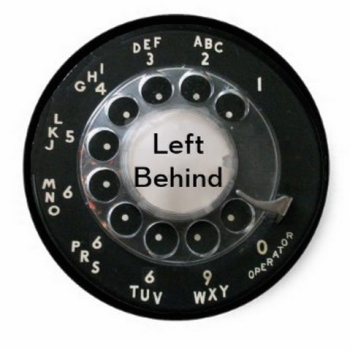I want to revisit a broad, sweeping generalization that I made here last week. I don’t want to qualify that here, just to clarify that it is, in fact, a broad, sweeping generalization and that it is also, in fact, accurate and true.
In the post “The white culture wars are about the ’60s — the 1860s” I wrote this: “The complete list of moral and social issues in America that have nothing to do with racism is that there aren’t any.”
I was pushing back there against the notion that there might be some category of “culture wars” that exists separately from the white backlash against the Civil Rights Movement. There is no such category. The “culture wars” are just other forms of that same backlash. Sometimes this is explicit and direct — a matter of obvious “dog whistles” or of even more obvious “dog farts.” Sometimes the connection is more indirect and elliptical. And sometimes the connection is the desperate disconnection of flailing attempts to change the subject, as in the what-aboutism of BWAA?
None of the “culture-war wedge-issues” would exist in anything like their current form if they were not also serving as proxies for the same white backlash that poured milkshakes on the heads of protesters at Woolworth’s lunch counters and that hurled epithets and tomatoes at Ruby Bridges and the Little Rock 9.
This is not a new or novel claim. Lee Atwater said exactly this. So did John Ehrlichman.
The so-called “culture wars” in America are always and everywhere expressions or outgrowths of the white backlash against the first and second Reconstructions.
But what about gender and feminism and anti-feminism? Isn’t that a vast, separate “culture war” arena of its own? Surely misogyny and patriarchy and the various obsessive phobias of the sex-pests are trouble enough, in their own way, independent of the white counterrevolution of the past two centuries?
I don’t want to diminish any of that with the broad, sweeping generalization above. And I certainly do not want to suggest some kind of hierarchy of oppressions or evils or injustices. The point of this BSG is not that white backlash is the only problem, but that here in America it shapes and influences every problem such that there is no such thing as a “culture-war issue” that is either separate from or independent of it. It touches everything.
Because we may be speaking in broad, sweeping generalizations, but these are not abstractions. Here in America, in the concrete reality of our actual world, every so-called social issue of the so-called culture wars serves as a proxy for Redemptionism. And at the same time, every such culture-war “social issue” also serves as a proxy for patriarchy. They go together like rama lama lama, ka dinga da dinga dong.
This is why within my own sectarian world of white American evangelical Christianity, the same people who are furious and terrified about Jesus and John Wayne are furious and terrified about The Color of Compromise. Kristin Kobes Du Mez has written a history that focuses on how patriarchy has “corrupted a faith and fractured a nation,” while Jemar Tisby’s history focuses on “the American church’s complicity in racism.” And yet neither those authors nor their furious critics regard these books as contradictory or competitive. I’d describe them as complementary if that word weren’t confused and tainted in this context by the use of “complementarianism” as a euphemism for patriarchy.
The self-proclaimed “complementarians” are uniformly upset by Du Mez’s incisive diagnosis of patriarchy and toxic masculinity. They immediately understood her book as a threat to their chosen identity and business model and reflexively attacked the book in defense of both. But some of those same “complementarians” initially attempted to be more receptive to Tisby’s evidence of white Christianity’s complicity in American racism. Alas, they soon found this unsustainable, quickly realizing that any meaningful attempt to address the pervasive injustice his book describes would entail the same kind of existential threat to their identity that Du Mez’s history poses.
All of which brings us to Stephen Young’s “Biblical Inerrancy’s Long History as an Evangelical Activist for White Patriarchy.” Young has done his homework and provides the receipts for that in his link-filled Religion Dispatches piece. So on one level, you can read this article as simply an attempt to provide historical context for recent social-media attacks on two women who authored books challenging white Christian patriarchy, but on another level you can focus on all those link-footnotes and treat the piece as a syllabus for an independent study class on the history of “biblical inerrancy” as a proxy for patriarchal white supremacy.
Here’s a chunk of Young’s discussion, beginning with Harold Lindsell’s The Battle for the Bible and the effort to encode and enforce “inerrancy” as a mandatory core of “evangelical” identity in the latter half of the 20th century:
Let’s un-erase this facet of inerrancy’s politics. At one point, Lindsell lauds the (white) Christians “south of the Mason-Dixon line” since “probably no other geographical region in the United States has had a better record for belief in the infallibility of the Word of God.” He wrote these words in the early 1970s about the very Christians who had upheld a brutal apartheid state, downplayed Jim Crow’s violence and exploitation, and reserved their harshest vitriol for the activists and Federal Government who sought to end it.
Lindsell would know. He became editor of Christianity Today toward the end of the Civil Rights era. As Dr. Curtis Evans shows, the magazine reserved its harshest criticism for integrationists. It also decried interracial marriage and promoted “voluntary integration”—what Dr. King called the “White Moderate” position that sought to delay justice for Black people until white feelings catch up (still waiting). When Lindsell treats “Ethical and Moral” issues, it’s the history of “ethical deceit and moral failure” of Christians who were not forthright about rejecting inerrancy. Complicity in a long White Supremacist regime of exploitation, subjugation, and terror does not register.
To focus on Lindsell’s silence about the White Supremacy of Southern upholders of biblical infallibility isn’t some woke tantrum. It’s a crucial part of thinking critically about the history of inerrancy. Jim Crow-era white Christians overwhelmingly advocated for and identified with the vicious racial caste system from which they benefitted.
And as Carolyn Renée Dupont and J. Russell Hawkins demonstrate, they did so in the name of biblical authority. Segregationist Christians made their preferred racial-economic hierarchy seem natural by presenting it as biblical, and they maligned anti-segregation Christians by critiquing their biblical exegesis and questioning their commitment to Christian truth. E. Earle Ellis, a New Testament professor and founder of the Institute for Biblical Research, provides a perfect example in his 1957 Christianity Today article, “Segregation and the Kingdom of God.” It contests Christian “integrationists” by labeling them “Secular,” asserting that they have their “roots in a secular view of the Kingdom of God,” and associating them with “Christian communism” as opposed to biblical truth.
That last link takes you to Christianity Today’s (paywalled) online archives. I suppose, on one level, it’s commendable that Ellis’s appalling argument hasn’t been erased or memory-holed in an attempt to sanitize the magazine’s ugly history. You’d think such articles — there are many others like it in CT’s archives — would require some introductory disclaimer or explanation to contextualize them for contemporary readers. But then it’s hard to imagine what such disclaimers might say, given that no part of Ellis’ argument from 1957 can’t be found repeated in 2022 Christianity Today articles fretting about the supposed dangers that “wokeness” or “critical race theory” pose to the real, true gospel of biblical inerrancy.
Note that none of the four paragraphs quoted above says anything directly about Young’s primary subject — “white patriarchy” and the nasty attacks being directed at Kristin Kobes Du Mez and Beth Allison Barr by white “complementarian” men on social media. That’s his main theme — that it’s impossible to understand these complementarians without understanding the political meaning and political function that “biblical inerrancy” has always had since 1865 or 1619 and that it cannot and would not exist without.
If you want to understand the white patriarchy of “complementarians,” then you have to understand the white supremacy that has shaped American “Bible Christianity” since its creation in the 17th century. They will always go together, together forever like shoo-wop shoo wadda wadda yippidy boom da boom.
NB: I owe an apology here to the vast majority of readers for the potential unwelcome earworm of the big finale from the musical Grease.
It’s also possible that I owe an explanation to any readers who may be unfamiliar with that song and who thus may be bewildered by the references above to the show-tune-ified phonetical representation of its doo-wop-inspired lyrics. Such readers might be better able to understand the reference there if I provided a link to Sandy and Danny and the entire company singing “We Go Together,” but then I consider the charmed lives these fortunate few readers have led up until now and I do not wish to be the one responsible for introducing them to something they have, thus far in their lives, been blessed to avoid.













